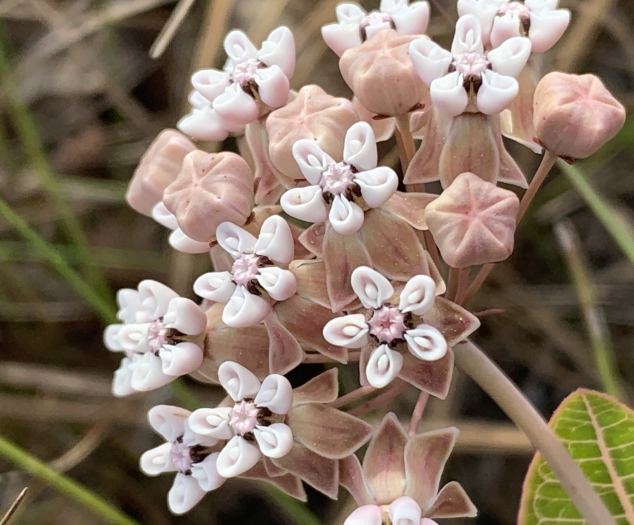Pinewoods Milkweed
(Asclepias humistrata)
Pinewoods Milkweed (Asclepias humistrata)
/
/

natalie
Public Domain
Image By:
natalie
Recorded By:
Copyright:
Public Domain
Copyright Notice:
Photo by: natalie | License Type: Public Domain | License URL: http://creativecommons.org/publicdomain/zero/1.0/ | Rights Holder: natalie | Publisher: iNaturalist | Date Created: 2021-04-03T20:47:33Z |















































Estimated Native Range
Summary
Asclepias humistrata, commonly known as Pinewoods Milkweed, is a deciduous perennial herb native to the sandy soils of pine flatwoods, sandhills, and other dry, open woodlands in the Southeastern United States. It typically grows from 0.3 to 0.9 meters (1 to 3 feet) tall and produces clusters of intricate flowers that are a blend of pink, lavender, and white, blooming in the spring and summer months. The flowers are quite showy and attract a variety of pollinators, especially butterflies, including the Monarch, which relies on milkweed species as a host plant for its larvae.
Pinewoods Milkweed is valued for its drought tolerance and ability to thrive in poor, well-drained soils, making it an excellent choice for xeriscaping and naturalistic plantings. It is also used in butterfly gardens due to its importance as a nectar source and larval food plant. While it prefers full sun, it can tolerate light shade. This milkweed is relatively low-maintenance but can be susceptible to root rot if overwatered or planted in poorly drained soils. It is not typically associated with aggressive roots or other significant problems. Gardeners should be aware that all parts of the plant contain toxic compounds that can be harmful if ingested.CC BY-SA 4.0
Pinewoods Milkweed is valued for its drought tolerance and ability to thrive in poor, well-drained soils, making it an excellent choice for xeriscaping and naturalistic plantings. It is also used in butterfly gardens due to its importance as a nectar source and larval food plant. While it prefers full sun, it can tolerate light shade. This milkweed is relatively low-maintenance but can be susceptible to root rot if overwatered or planted in poorly drained soils. It is not typically associated with aggressive roots or other significant problems. Gardeners should be aware that all parts of the plant contain toxic compounds that can be harmful if ingested.CC BY-SA 4.0
Plant Description
- Plant Type: Herb
- Height: 1-3 feet
- Width: 0.333-1 feet
- Growth Rate: Moderate
- Flower Color: Pink, White
- Flowering Season: Spring, Summer
- Leaf Retention: Deciduous
Growth Requirements
- Sun: Full Sun
- Water: Low
- Drainage: Fast
Common Uses
Bee Garden, Bird Garden, Butterfly Garden, Deer Resistant, Drought Tolerant, Fragrant, Hummingbird Garden, Low Maintenance
Natural Habitat
Native to sandy soils of pine flatwoods, sandhills, and other dry, open woodlands in the Southeastern United States
Other Names
Common Names: Sandhill Milkweed, Pink-Veined Milkplant
Scientific Names: , Asclepias humistrata, Asclepias amplexicaulis,
GBIF Accepted Name: Asclepias humistrata Walter